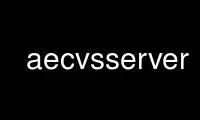
This is the command aecvsserver that can be run in the OnWorks free hosting provider using one of our multiple free online workstations such as Ubuntu Online, Fedora Online, Windows online emulator or MAC OS online emulator
PROGRAM:
NAME
aecvsserver - serve CVS client protocol against Aegis projects
SYNOPSIS
aecvsserver server
aecvsserver pserver
aecvsserver -VERSion
DESCRIPTION
The aecvsserver command is used to serve the CVS client protocol. The repository, of
course, is stored within Aegis.
The server works by retrieving file contents from locations within Aegis change sets and
repositories. When necessary, appropriate aegis(1) commands are executed by the server
to fulfill the requests.
This code is still experimental. At the present time only a limited number of CVS
commands are understood. If you would like to extend this code, contributions are
welcome. The following commands are thought to work at this time: add, admin, checkout,
commit, init, remove, update.
server
To use the server, you will need to set the following environment variables:
CVSROOT=:ext:hostname/aegis
CVS_RSH=ssh
CVS_SERVER=aecvsserver
pserver
It is also possible to use aecvsserver as a cvs pserver, with all the usual caveats about
how insecure this access method is, because it transmits the password almost in the
clear. The root and modules are as above.
MODULES
The CVS concept of modules is mapped onto Aegis concept of projects and changes. The
special CVSROOT administrative module is simulated.
Projects as Modules
Each Aegis project appears to the CVS client as a module; the module's name is the same
as the Aegis project's name. This type of module isn't immediately useful except for the
cvs export command, or to perform a read-only cvs checkout command.
You can't commit to a project-named module. This because Aegis requires all operations
which would change the repository to be performed through a change set.
It is theoretically possible to code aecvsserver to create a change (via aenc(1) and
aedb(1) commands), then add the necessary files (via aenf(1) and aecp(1) commands), then
build (via the aeb(1) command), then test (via the aet(1) command), and finally to end
development of the change (via the aede(1) command). As the CVS protocol documentation
says
"The protocol makes it possible for updates to be atomic with respect to
checkins; that is, if someone commits changes to several files in one cvs
command, then an update by someone else would either get all the changes, or none
of them. The current cvs server can't do this, but that isn't the protocol's
fault."
This code is yet to be written. Contributions welcome.
The protocol, however, doesn't make it particularly easy, either. The semantics of the
Modify request change depending on whether it is followed by the commit request or the
update request.
Changes as Modules
Each Aegis change set also appears to the CVS client as a module; it's name is
project.Cnumber. All cvs add commands, cvs remove commands, cvs update commands and cvs
commit commands are performed against the change set, not directly to the baseline. It
is necessary for the change set to already exist, and once you have run the cvs commit
command, it will the be necessary to use the aede(1) command and the rest of the usual
Aegis process.
Once a change is no longer in the being developed state, it cannot be changed via
aecvsserver(1) and you will need to create a new Aegis change set, and then cvs checkout
a new client-side work area.
Please note: if you are experimenting with the interface via cvs -d :fork:/aegis or
similar, the work area you create must be outside the Aegis change set's development
directory.
CVSROOT
The CVSROOT module's contents are synthesized from Aegis meta-data. You can't add or
modify files in this module; you need to administer Aegis directly with aegis(1)
commands.
EXIT STATUS
The aecvsserver command will exit with a status of 1 on any error. The aecvsserver
command will only exit with a status of 0 if there are no errors.
ENVIRONMENT VARIABLES
See aegis(1) for a list of environment variables which may affect this command. See
aepconf(5) for the project configuration file's project_specific field for how to set
environment variables for all commands executed by Aegis.
COPYRIGHT
aecvsserver version 4.24.3.D001
Copyright (C) 1991, 1992, 1993, 1994, 1995, 1996, 1997, 1998, 1999, 2000, 2001, 2002,
2003, 2004, 2005, 2006, 2007, 2008, 2009, 2010 Peter Miller
The aecvsserver program comes with ABSOLUTELY NO WARRANTY; for details use the
'aecvsserver -VERSion License' command. This is free software and you are welcome to
redistribute it under certain conditions; for details use the 'aecvsserver -VERSion
License' command.
Use aecvsserver online using onworks.net services
